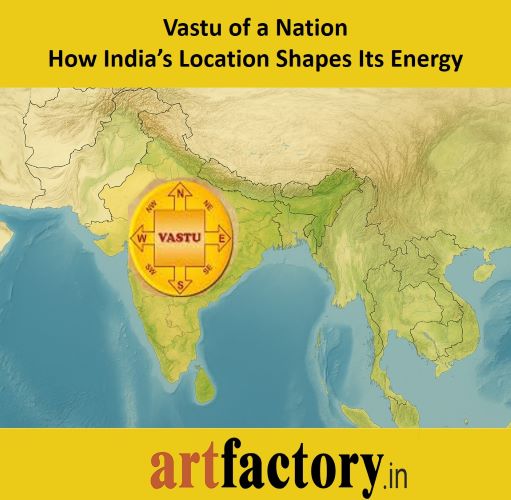
Vastu of a Nation: How India’s Location Shapes Its Energy
India, with its ancient roots in Vedic sciences, is often viewed as a land aligned with cosmic and natural energies. One of the most significant of these sciences is Vastu Shastra, which emphasizes the importance of directional energies, elemental balance, and geographic location. Just like homes and buildings, countries too can be analyzed through the lens of Vastu. India’s geographical position on the globe has its own set of advantages and disadvantages from a Vastu perspective.
India’s Vastu Profile:
Geographical Coordinates: India lies approximately between 8°N and 37°N latitudes and 68°E to 97°E longitudes.
Shape and Orientation: Triangular in the north and wider in the south.
Major Directions:
North-East (Ishan Kona): Himalayas
South-East (Agneya): Bay of Bengal
South-West (Nairutya): Arabian Sea
North-West (Vayavya): Pakistan, Afghanistan borders
Advantages of India’s Location as per Vastu:
1. Strong North-East (Ishan Kona) – Spiritual Growth and Wisdom
The presence of the Himalayas in the North-East is seen as highly auspicious. In Vastu, the North-East represents spiritual energy, clarity, and divine blessings.
This may explain India’s identity as a spiritually rich and wisdom-centric nation, home to multiple philosophies, saints, and yoga traditions.
2. Open South-East (Agneya) – Fire Element and Trade
The Bay of Bengal lies in the South-East, which is associated with the Agni (fire) element.
Water in the South-East supports trade, commerce, and industrial growth, especially along the Eastern coast—major port cities like Chennai and Visakhapatnam have prospered.
3. Elevated North-West (Vayu Kona) – Defense and Air Flow
The North-West is linked to air, movement, diplomacy, and trade. India’s land border here supports its strategic defense posture.
The Vastu principle of having heavier structures in the South and West and lighter, open spaces in the North and East aligns well with the way India's geography is structured.
4. Sloping South and West – Draining of Negativity
The landmass slopes from North to South and East to West, allowing natural drainage of water and energy. This is largely in sync with ideal Vastu topography.
Disadvantages of India’s Location as per Vastu:
1. Water Bodies in the South-West – Financial Drain and Instability
The Arabian Sea lies to the South-West, which is traditionally a direction that should be heavy and stable in Vastu.
A water body here may create economic volatility, political instability, or susceptibility to foreign influence.
This could be interpreted as India’s colonial past and occasional economic setbacks due to external global forces.
2. Desert in the North-West (Thar Desert) – Imbalance of Vayu Tatva
The North-West being dominated by desert land (Rajasthan) can signify excess air element, leading to instability, migration, and conflict—which can be metaphorically linked to border tensions with neighboring countries in this direction.
3. Uneven Development Due to Directional Energies
The Eastern and Southern regions, being closer to water bodies, have seen significant industrial growth and urban development.
The interior North-West and central belt often face challenges like water scarcity, infrastructure lags, and socio-political unrest—this may reflect directional imbalances according to Vastu principles.
Conclusion:
India’s geographical placement presents a fascinating case of Vastu alignment on a national scale. With a powerful North-East, resource-rich East, and defensive North-West, India is blessed with spiritual strength, diversity, and resilience. However, the water in the South-West and air imbalance in the North-West hint at areas that may require attention, both symbolically and structurally.
By applying the principles of Vastu Shastra not just at home but at a macro level, we can appreciate how geography, energy, and culture interact. As India moves toward becoming a global power, aligning with its natural strengths and correcting its energetic imbalances could be the way forward.
FAQ:
Q1. How is India’s location analyzed in Vastu Shastra?
A: India is evaluated based on its directional orientation, land slope, presence of natural features like mountains, deserts, and seas, and their alignment with the five elements of Vastu Shastra.
Q2. What is the biggest Vastu advantage for India?
A: The strong and elevated North-East with the Himalayas brings spiritual strength, wisdom, and divine energy to the country.
Q3. What is a major Vastu disadvantage for India?
A: The presence of the Arabian Sea in the South-West, which should ideally be heavy and stable, may lead to financial or political instability.
Q4. How does the Bay of Bengal in the South-East benefit India?
A: It activates the fire element and supports industrial growth, trade, and dynamic economic activity.
Q5. Can a country’s development be linked to Vastu?
A: Yes, Vastu Shastra believes that directional and elemental imbalances or strengths can influence a nation’s prosperity, stability, and progress.
To read more,click on:https://www.artfactory.in/blog/vastu-tips-for-new-home-construction
For more details,visit:https://www.artfactory.in/category/vastu-feng-shui

Comments : (0)